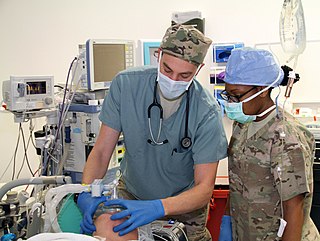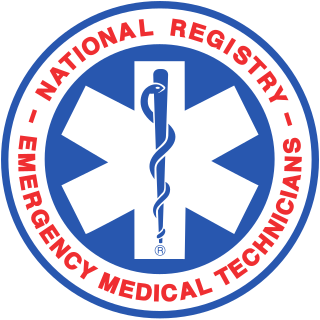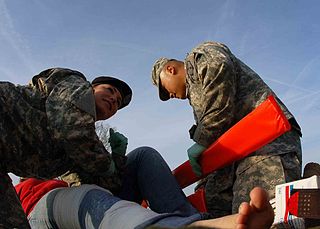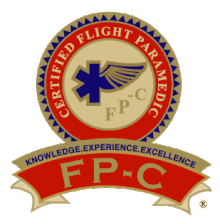Professional certification, trade certification, or professional designation, often called simply certification or qualification, is a designation earned by a person to assure qualification to perform a job or task. Not all certifications that use post-nominal letters are an acknowledgement of educational achievement, or an agency appointed to safeguard the public interest.

An emergency medical technician (EMT), also known as an ambulance technician, is a health professional that provides emergency medical services. EMTs are most commonly found working in ambulances. In English-speaking countries, paramedics are a separate profession that has additional educational requirements, qualifications, and scope of practice.

Anesthesiology, anaesthesiology, or anaesthesia is the medical specialty concerned with the total perioperative care of patients before, during and after surgery. It encompasses anesthesia, intensive care medicine, critical emergency medicine, and pain medicine. A physician specialized in anesthesiology is called an anesthesiologist, anaesthesiologist, or anaesthetist, depending on the country. In some countries, the terms are synonymous, while in other countries they refer to different positions, and anesthetist is only used for non-physicians, such as nurse anesthetists.
Project Management Professional (PMP) is an internationally recognized professional designation offered by the Project Management Institute (PMI). As of 31 July 2020, there are 1,036,368 active PMP-certified individuals and 314 chartered chapters across 214 countries and territories worldwide.

In the United States, the paramedic is a professional whose primary focus is to provide advanced emergency medical care for critical and emergency patients who access Emergency Medical Services (EMS). This individual possesses the complex knowledge and skills necessary to provide patient care and transportation. Paramedics function as part of a comprehensive EMS response, under medical oversight. Paramedics perform interventions with the basic and advanced equipment typically found on an ambulance. The paramedic is a link from the scene into the health care system. One of the eligibility requirements for state certification or licensure requires successful completion of a nationally accredited Paramedic program at the certificate or associate degree level. Each state varies in requirements to practice as a paramedic, and not all states require licensure.
Established in 1933, the American Board of Medical Specialties (ABMS) is a non-profit organization which represent 24 broad areas of specialty medicine. ABMS is the largest physician-led specialty certification organization in the United States.

The American Board of Otolaryngology, located in Houston, Texas, is a non-profit corporation that has set the mission of ensuring professional standards with certificates and memberships, and have offered training in the fields of head neck surgery to professionals since 1924.

Emergency nursing is a specialty within the field of professional nursing focusing on the care of patients who require prompt medical attention to avoid long-term disability or death. In addition to addressing "true emergencies," emergency nurses increasingly care for people who are unwilling or unable to get primary medical care elsewhere and come to emergency departments for help. In fact, only a small percentage of emergency department (ED) patients have emergency conditions such as a stroke, heart attack or major trauma. Emergency nurses also tend to patients with acute alcohol and/or drug intoxication, psychiatric and behavioral problems and those who have been raped.
A flight paramedic is a paramedic who provides care to sick and injured patients in an aeromedical environment. Typically a flight paramedic works with a registered nurse, physician, respiratory therapist, or another paramedic. Flight paramedics must have an advanced medical knowledge along with years of clinical experience. Flight paramedics in the United States usually hold certifications such as the FP-C or the CCP-C, while in countries like the United Kingdom, they are typically required to hold a postgraduate certificate in critical care as a minimum, with many holding a master's degree in advanced practice or aeromedical critical care.
The American Board of Surgery (ABS) is an independent, non-profit organization located in Philadelphia, Pennsylvania, founded for the purpose of certifying surgeons who have met a defined standard of education, training and knowledge. Surgeons certified by the ABS, known as diplomates, have completed a minimum of five years of surgical residency training following medical school and successfully completed a written and oral examination process administered by the ABS. The ABS provides board certification in general surgery, vascular surgery, pediatric surgery, surgical critical care, surgery of the hand, hospice and palliative medicine, and complex general surgical oncology.
Board certification is the process by which a physician or other professional demonstrates a mastery of advanced knowledge and skills through written, practical, or simulator-based testing.

The National Registry of Emergency Medical Technicians is a US certification agency covering prehospital medical providers.
Advanced emergency medical technicians (AEMT) are providers of prehospital emergency medical services in the United States. A transition to this level of training from the emergency medical technician-intermediate (EMT-I), which have somewhat less training, began in 2013 and has been implemented by most states at this point. The AEMT is not intended to deliver definitive medical care in most cases, but rather to augment prehospital critical care and provide rapid on-scene treatment. AEMTs are most usually employed in ambulance services, working in conjunction with EMTs and paramedics, however are also commonly found in fire departments and law enforcement agencies as non-transporting first responders. Ambulances operating at the AEMT level of care are commonplace in rural areas, and occasionally found in larger cities as part of a tiered-response system, but are overall much less common than EMT- and paramedic-level ambulances. The AEMT provides a low-cost, high-benefit option to provide advanced-level care when the paramedic level of care is not feasible. The AEMT is authorized to provide limited advanced life support, which is beyond the scope of an EMT.
Emergency Medical Technician is the entry level of Emergency Medical Technician in the United States.
In the United States, the licensing of prehospital emergency medical providers (EMTs) and oversight of emergency medical services are governed at the state level. Each state is free to add or subtract levels as each state sees fit. Therefore, due to differing needs and system development paths, the levels, education requirements, and scope of practice of prehospital providers varies from state to state. Even though primary management and regulation of prehospital providers is at the state level, the federal government does have a model scope of practice including minimum skills for EMRs, EMTs, Advanced EMTs and Paramedics set through the National Highway Traffic Safety Administration (NHTSA).

Emergency medical responders are people who are specially trained to provide out-of-hospital care in medical emergencies. There are many different types of emergency medical responders, each with different levels of training, ranging from first aid and basic life support. Emergency medical responders have a very limited scope of practice and have the least amount of comprehensive education, clinical experience or clinical skills of emergency medical services (EMS) personnel. The EMR program is not intended to replace the roles of emergency medical technicians or paramedics and their wide range of specialties. Emergency medical responders typically assist in rural regions providing basic life support where pre-hospital health professionals are not available due to limited resources or infrastructure.
The International Association of Flight and Critical Care Paramedics is a non-profit organization that represents critical care paramedics that transport critically ill or injured patients by means of airborne or ground vehicles. Established in 1986 as the National Flight Paramedic Association (NFPA) the IAFCCP was founded with the purpose of providing education and representation to flight paramedics and, as of February 2011, has expanded their representation to ground critical care paramedics.
The Certified Professional Organizer (CPO) designation is an experience and exam-based certification for professionals who have met specific minimum standards, and proven through examination and client interaction that they possess the requisite body of knowledge and experience.
The National Board for Respiratory Care (NBRC Inc. is a non-profit organization formed in 1960 with the purpose of awarding and maintaining credentialing for Respiratory Therapists in the United States. The NBRC is the only organization in the United States which develops certification examinations for Registered Respiratory Therapists and Certified Respiratory Therapists. The NBRC also offers additional specialization credentialing for respiratory practitioners that hold its certifications. The CRT and RRT designations are the standard credential in respiratory care for licensure requirements in the portions of the United States that have enacted a Respiratory Care Act. States that license respiratory therapists sometimes require the practitioner to maintain their NBRC credentialing to maintain their license to practice. The NBRC is headquartered in Overland Park, Kansas. It has been in the Kansas City metropolitan area since 1974. The NBRC is located at 10801 Mastin St, Suite 300, Overland Park, KS 66210.







